



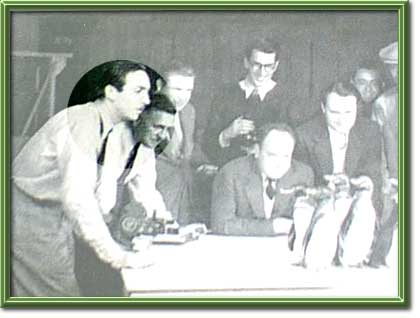
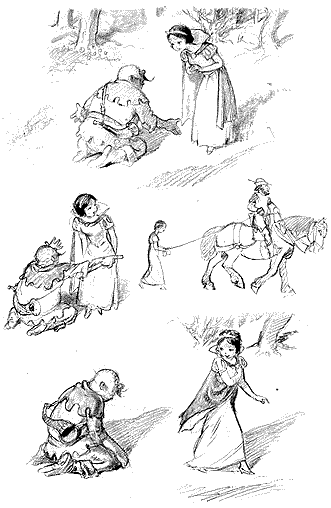 Until
the 1996 release of John Canemaker's excellent Before the Animation
Begins, little was known about Albert Hurter beyond his work
and the anecdotal remembrances of those who worked with him at
Disney and Barre-Bowers. Thanks to Mr. Canemaker, we have a very
real biography of the man behind Walt Disney's most memorable
animated films.
Until
the 1996 release of John Canemaker's excellent Before the Animation
Begins, little was known about Albert Hurter beyond his work
and the anecdotal remembrances of those who worked with him at
Disney and Barre-Bowers. Thanks to Mr. Canemaker, we have a very
real biography of the man behind Walt Disney's most memorable
animated films.
Born in 1883 in Switzerland, Hurter was given a very solid art education. He studied architecture for three years in Zurich and art for seven years in Berlin. It was probably a very classical and traditional course of study, well-grounded in basic drawing skills. He came to America in 1913 or 1914 and by 1915 was firmly ensconced in the fledgling animation industry doing Mutt & Jeff cartoons for Barre-Bowers in New York. Utilizing his keen eye for movement and his extensive art training, Hurter quickly became a phenomenon who could replicate action based on analysis of nature. This may sound like a definition of animation, and if so, he was one of the early pioneers who helped to teach that definition to his cohorts who had little training and were making up the process as they went.
From 1918 to the late 20's, Hurter drops from sight. Around
1930, he was living a quiet, eccentric life in Southern California
drawing direct mail ads for a printer. When he applied for an
animation job at the Disney Studios, he was 48 years old (Walt
was 29) with antiquated animation skills and an undistinguished
career behind him. What lay before him was the job he was born
to do.
 Credit Walt
Disney for seeing the potential in his talents. Hurter could draw,
draw quickly, understood movement and had a playful, often surrealistic
approach to cartooning. His anthropomorphic tendencies and his
comic designs were the germs that were needed in an industry that
set out to make people laugh.Walt saw these abilities and make
Hurter what Canemaker calls an "inspirational sketch artist."
Disney would rely heavily on such talents throughout his career,
but Hurter was the first and surely the prototype.
Credit Walt
Disney for seeing the potential in his talents. Hurter could draw,
draw quickly, understood movement and had a playful, often surrealistic
approach to cartooning. His anthropomorphic tendencies and his
comic designs were the germs that were needed in an industry that
set out to make people laugh.Walt saw these abilities and make
Hurter what Canemaker calls an "inspirational sketch artist."
Disney would rely heavily on such talents throughout his career,
but Hurter was the first and surely the prototype.
 He
was the old man of the studio. His exposure to the European art
world and artists like Heinrich
Kley and Wilhelm Busch, his encyclopedic memory for details,
and his fertile, creative mind made him indispensable to both
the studio and the young animators. Though basically a loner,
his talents touched many a Disney artist.
He
was the old man of the studio. His exposure to the European art
world and artists like Heinrich
Kley and Wilhelm Busch, his encyclopedic memory for details,
and his fertile, creative mind made him indispensable to both
the studio and the young animators. Though basically a loner,
his talents touched many a Disney artist.
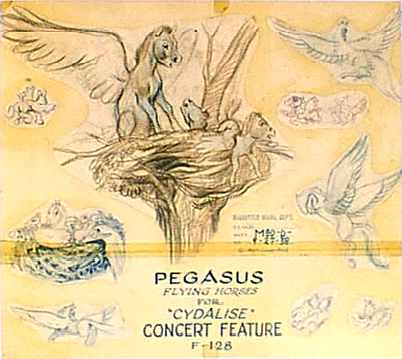 His
job was to draw and sketch, to play with images and ideas. They'd
tell him, "The Three Little Pigs" and he'd be off for
days doodling and drawing and designing and the results were quickly
passed to the other departments to be mined for ideas. His sketches
were the foundations for most of the Disney films of the Thirties.
He designed characters and settings for Silly Symphonies, Snow
White and Seven Dwarfs, Pinocchio, Fantasia, Dumbo, Reluctant
Dragon, and even films that were to be made long after his
death. His designs can be found in Peter Pan (see the pirate
eating eyeballs above - one of dozens of exploratory drawings
for Peter Pan that can be found in He Drew As He Pleased)
and Lady and the Tramp. One of the model sheets from Fantasia
for the Pegasus is comprised of nine Hurter sketches. (Image is
from Before the Animation Begins and is ©
1996 by Disney Enterprises, Inc.) So many films and characters
of the time began life on Hurter's drawing board.
His
job was to draw and sketch, to play with images and ideas. They'd
tell him, "The Three Little Pigs" and he'd be off for
days doodling and drawing and designing and the results were quickly
passed to the other departments to be mined for ideas. His sketches
were the foundations for most of the Disney films of the Thirties.
He designed characters and settings for Silly Symphonies, Snow
White and Seven Dwarfs, Pinocchio, Fantasia, Dumbo, Reluctant
Dragon, and even films that were to be made long after his
death. His designs can be found in Peter Pan (see the pirate
eating eyeballs above - one of dozens of exploratory drawings
for Peter Pan that can be found in He Drew As He Pleased)
and Lady and the Tramp. One of the model sheets from Fantasia
for the Pegasus is comprised of nine Hurter sketches. (Image is
from Before the Animation Begins and is ©
1996 by Disney Enterprises, Inc.) So many films and characters
of the time began life on Hurter's drawing board.
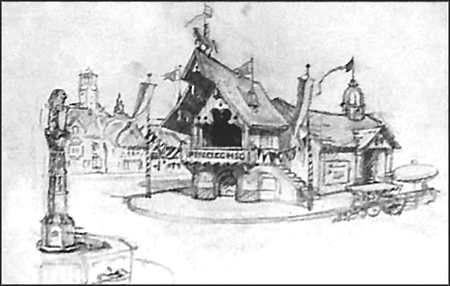 His
ability to render form and to recreate a sense of place were legendary.
The middle-European feel of Pinocchio is often credited
solely to Gustaf Tenggren,
but it is equally the result of Hurter's talents. (See the drawing
at left from The Art of Walt Disney.)
His
ability to render form and to recreate a sense of place were legendary.
The middle-European feel of Pinocchio is often credited
solely to Gustaf Tenggren,
but it is equally the result of Hurter's talents. (See the drawing
at left from The Art of Walt Disney.)
He died of a weak heart caused by rheumatic heart disease in 1942. He'd suffered from rheumatic fever as a child and a weak heart all his life. In his will, he arranged for the publication of a book on his work. "Arranged and captioned" by fellow Disney worker Ted Sears, He Drew As He Pleased features over 700 of Hurter's amazing doodles and drawings. The ideas they sparked are both obvious and subtle, and gags based on them often appeared in films other than the ones for which they were originally concocted. Canemaker's book is the source for the startling fact that it was financed by Hurter. We'd always thought it was a tribute by Disney and/or his co-workers.


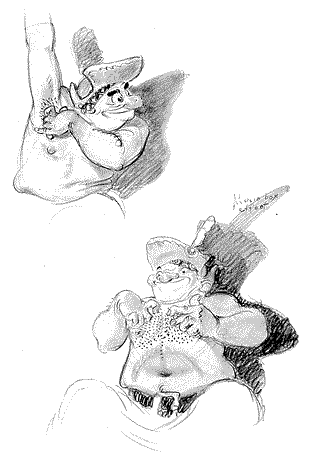
Three pages above are from He Drew As He Pleased and
show the vast range and the fertile imagination of this incredible
artist. Below is a detail of the first image on this page showing
the character of Snow White already fully developed from the very
earliest sketches and giving you a better view of the facile beauty
of Hurter's art.
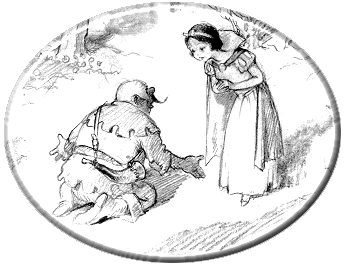 There
just aren't that many places one can go to find Hurter's work.
Certainly the actual animated cartoons display his creativity,
but isolating his exact contributions can be tricky. I highly
recommend Before the Animation Begins which may be still available.
This excellent book features chapters on all of
the "Inspirational Sketch Artists" including Ferdinand
Horvath, Gustaf Tenggren,
James Bodrero, Kay
Nielsen, Bianca Majolie, Sylvia Moberly-Holland, Mary Blair,
Tyrus Wong, David Hall, Eyvind Earle, Ken Anderson and an entire
chapter on the artists creating the inspirations for today's Disney
cartoons.
There
just aren't that many places one can go to find Hurter's work.
Certainly the actual animated cartoons display his creativity,
but isolating his exact contributions can be tricky. I highly
recommend Before the Animation Begins which may be still available.
This excellent book features chapters on all of
the "Inspirational Sketch Artists" including Ferdinand
Horvath, Gustaf Tenggren,
James Bodrero, Kay
Nielsen, Bianca Majolie, Sylvia Moberly-Holland, Mary Blair,
Tyrus Wong, David Hall, Eyvind Earle, Ken Anderson and an entire
chapter on the artists creating the inspirations for today's Disney
cartoons.
Otherwise seek out and find a copy of He Drew As He Pleased. The price is high but it's a very special book that you'll never get tired of revisiting. My highest recommendation and one of my most prized possessions.
 To learn more about Albert Hurter, see:
To learn more about Albert Hurter, see:
| Before the Animation Begins | John Canemaker, 1996 Hyperion |
| The Art of Walt Disney | Christopher Finch, 1973 Abrams |
| He Drew As He Pleased | 1948 Simon & Schuster |
| The Vadeboncoeur Collection of Knowledge | Jim Vadeboncoeur, Jr. 1997 |
|
Illustrations copyright by
Walt Disney Productions, et al. This page written, designed & © 1997 by Jim Vadeboncoeur, Jr. Updated 2011. |
